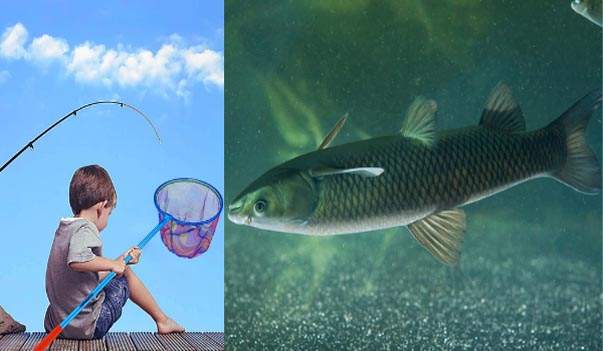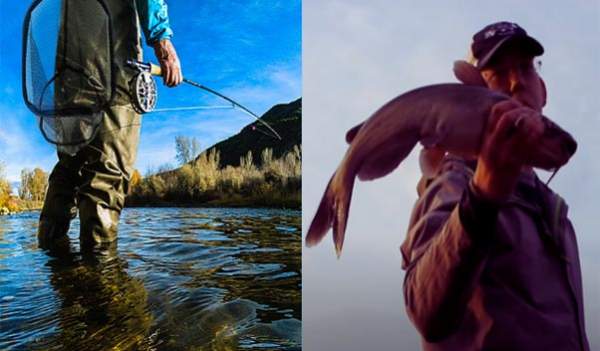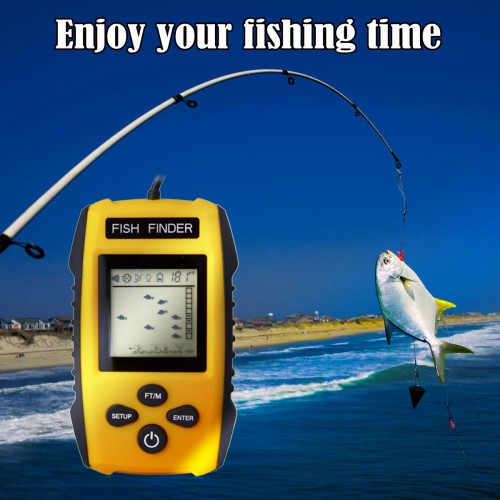Last updated on July 16th, 2021 at 10:00 am
Last updated on July 16th, 2021
Grass carp is a type of fish that originated from Asia. It was introduced to the US and Europe to help with weed control. It’s a big fish with a thick and elongated body. Their eyes are quite small for their sizes, and the eyes are centered on the side of their heads. The fish has no barbels but has overlapping scales and very firm lips.
The fish can grow very fast and can reach up to 1.9 to 2.3 feet long (60 to 100 cm). A fully grown grass carp can reach up to 88 pounds (40 kg). The fish come in different colors, from grey to olive-green on the back. Some also have yellow, silverish, or brown colors on their sides. Their bottoms are mostly white.
Grass carp is a very delicious fish, explaining why many fishermen follow it. Grass carp isn’t easy to catch because it likes putting up a fight. But this also makes it fun to fish in the huge grass carp populations. Want to learn how to catch grass carp with your fishing skills? Read on to find pro tips on fishing for grass carp.
Things You Need to Fish Grass Carp
To enjoy your fishing expedition and come home with many grass carp, you need the following gear to catch your target grass carp:
- A fishing rod: The fishing rod should be strong because grass carp are heavy fish. Your rod should be about 7 feet in length.
- A small hook: The fact that a grass carp is big and heavy doesn’t mean you need a big hook. In fact, you need just a small circle hook.
- Reel: You’ll need a reel that holds not less than 200 yards (about 180 m) of line.
- Landing net: A landing net isn’t used for catching the fish parse. As stated earlier, grass carp can be quite massive. Imagine having a 50 lb grass carp at the shore without a net. It can easily spit the hook and jump back into the water.

How to Attract Grass Carp
For your fishing expedition to be successful, you must be able to attract the common carp then catch it. Targeting grass carp is crucial if you want to catch a huge grass carp. It all starts with pre-baiting, something you can do some days before you go for the actual fishing. If that isn’t possible, you can pre-bait on the same day and time of your fishing. You need the right gear to do this.
For pre-baiting, anglers use bread, cut grass, or even corn to catch a grass carp. You can even use what anglers refer to as “salad”. It’s a mixture of fruit/vegetables, and lettuce.
Prebaiting is to make grass carp think the area you are tending to fish in is rich in food. However, you don’t need to overfeed the fish. The fish should be hungry by the time you are lowering your bait.
Toss your pre-baiting item into the water about three to six meters (10 to 20 feet) away from the shoreline, and wait for a moment. Choose an area that’s free from obstacles, both on the shore and under the water.
You don’t want your bait to get entangled under the water, and you also need a clear path to carry the fish away after catching it. The prebaiting mixture you use may attract other fish types. If you don’t want this to happen, use food that’s only liked by grass carps, e.g. cherry tomatoes or fruits. Once you throw in the prebaiting item, wait until it settles before presenting your bait.
What Size Hook Is Ideal for Grass Carp
As already mentioned, catching grass carp only needs a small hook. But what’s the best hook size? Choosing the right pieces of equipment is the first step. Grass carp can get quite big. For the biggest fish, you’ll need hooks in the size range of No. 1 to 2/0. However, hook sizes in the range of No.4, or a little larger will suffice for many fish sizes, especially the small ones.
The best hooks to catch grass carp are the circle hooks. These hooks are designed such that they normally puncture the side of the fish’s mouth when it takes the bait. This way, the fish won’t be able to escape easily. Also known as non-offset hooks, these circle hooks lower the chances of injuries and can be used for the catch and release method.
Ensure you buy your hooks from reputable manufacturers. The hooks should be new and sharp to be effective. Low-quality hooks change shape and break easily during high-impact fights.

Step by Step Guide On How to Catch Grass Carp
Grass carps are available in many regions like eastern Asia, pacific drainages, Chinese Siberian border among others. You can catch grass carp because they are in many private lakes and other fishing areas. Catching a grass carp is a skill that many anglers should learn. You need the right fishing tips for targeting carp. As stated before, grass carp can weigh as high as 80 pounds or more and are known to be resistant, making them the best fish for fun-fishing. To fish grass carp, follow the steps below:
Step 1: Start with stocked lakes and ponds
Grass carp fish are non-native species, so you’ll get them in fish farms, reservoirs, lakes, and private ponds where they are bred to control excess vegetation. You might have to seek permission from landowners or local authorities before you go fishing for grass carp.
Step 2: Use corn trick
Before your actual fishing day, sprinkle a few cans of some mix canned corn in the area you are intending to fish in. This will help attract grass carp to this area. You can mix the corn with some bread crumbs to form a favorable mixture for the grass carp.
Step 3: Have the right gear
To successfully catch grass carp, you need a fast-action, medium-heavy, 7-foot rod. It’s only such a rod that will provide enough support for the fish and is also sensitive enough for you to feel a bite on your bait. Medium spinning reels are better, especially if their gear ratios are medium. Grass carp will only fall for your bait when it’s relatively loose. So don’t keep it tight. Give the fish enough room to run without the line breaking.
Step 4: Setting Up the Fishing Equipment
The way you set up your fishing equipment matters a lot. Apart from the fishing line and the rod, you need a bait holder hook. Circular hooks are the best to prevent injuries. Circle hooks fit well in the grass carp’s mount.
The bait should cover the hook completely to prevent the fish from getting suspicious. Your reel should also be long enough to prevent any drag which can cause the fish to run away. Your fishing line shouldn’t be very visible, otherwise, the fish will hesitate to bite or even avoid it completely.

Step 5: Maintain a good tackle:
For the best fishing experience, use about 20-pound test fluorocarbon or monofilament rigged with size 2/0 or 1/0 live bait on your circle hook.
Step 6: Load the veggies
If you are using veggies as your bait, this is the time to load them. You can as well use the fish salad that had been mentioned earlier or any other baiting item you have. Grass carp are vegetarians. They like lima beans, green beans, watermelon rind, celery, lettuce, or grass clippings, provided they are fresh. If you want to catch the fish in a pond, your best bet would be cherry tomatoes.
Step 7: Let the Reel Feel the Spool
The best way to catch grass carp is to drop a bait with minimal resistance. Your line should be slack. Once they bite the bait, reel the line slowly to set the hook. The fish won’t realize it has been nabbed. While doing all these, you need to tread lightly. These fish are very sensitive and can be spooked easily. Wear clothes that blend well with the surroundings so they don’t notice you easily.
As stated, grass carp are very sensitive creatures. They are very cautious about their surroundings and any form of disturbance will scare them away. So, what do you need to do?
Move slowly
Remember that grass carp can see you even if they are under the water. They are extremely sensitive to movements or sounds. So when moving toward the shore, be very careful not to scare them away. Move slowly watching your steps. When you move very fast, they’ll consider you to be a threat and run away.
Be Patient
Sometimes it may take a little longer for grass carp to bite your bait. This mainly occurs if they had been scared. If that’s the case, give them time to relax and start moving out of their hiding places.
Also, remember that when you lower the bait, the fish will not rush to bite it, no matter how hungry it is. The fish will take time to observe the bait, sniff it, check and nibble at it. It’s only after the fish is convinced the bait is safe that it will bite it.
So, patience pays for successful grass carp fishing. If you try to treat grass carp like other types of fish, you’ll spook them and destroy your fishing expedition.
Cast carefully
Poor casting can also scare the fish. Casting should be gentle and slow. Don’t carelessly throw the line into the water with a splash. Fast reeling, erratic movements, and water disturbance will spoil your fishing. If you notice that your casting has scared them away, give them time to cool down or try casting in a different area. Once you cast, keep the line tension-free. These fish don’t like feeling any resistance.
When the Fish is Fighting, Outsmart it
Grass carp will not go easily without putting up a fight, and the fight can be extremely hard. The moment the fish realizes it has been caught, the fight will elevate from bad to worse. The situation will get worse the moment it gets out of the water and sees you plus the net.
In most cases, the fish will start jumping, bitting, throwing around in an uncontrolled and erratic fashion. These movements may end up breaking your rod and cutting the line. And if you aren’t careful, the fish can jump right back into the water.
How do you handle this? When you notice such erratic behavior, release more lines for the fish. This will prevent hard and destructive impacts. Try to control the fish until it stops the crazy movements. Once the fish is calm, you can reach for it very fast, get it out of the water and onto the net.
Now that you know how to catch grass carp, what’s remaining between you and that fishing expedition you are longing for is a fishing license.
Frequently Asked Questions
Q: What is the best bait for grass carp?
A: Unlike spotted bass and largemouth, grass carp are vegetarians. That’s why they are good at clearing lakes and ponds of vegetation. The best bait for them includes dough balls, earthworms, watermelon, cherry tomatoes, sweet corn, and man-made bait.

Q: How do you catch grass carp in a pond?
A: You can catch them in a pond the same way you do in a river or lake – using bait. You can as well use a fishing net if the pond is small.
Q: What is the best thing to catch carp on?
A: Dough balls or canned corn are the best things to catch grass carp on. But first, check whether the fishing regulations in your state permit the use of these baits.
Q: Do Grass carp feed on surfaces?
A: You can find them in ponds, lakes, or slowly moving waters. They spend a lot of their time hiding but near water surfaces. They can feed on the surface or just below the water surface.
Q: Are Grass Carp Bottom Feeders?
A: Yes, they are bottom feeders. They normally stir the bottom to collect aquatic plants, zooplankton, and invertebrates. However, this doesn’t mean they can’t feed on the surface.
Q: Do Grass Carp Have Teeth?
A: Yes, they have teeth. Their pharyngeal teeth are arranged in a 2-4 and 4-2 formation. Their teeth are ridged and broad.
Q: Are Grass Carp Good to Eat?
A: Yes, they are tasty and harmless. There are many ways of preparing them. Many people prefer frying them, but you can even use them in making fillets after removing the bones.
Conclusion
There you have it. You now know how to get hold of grass carp. As a reminder, make sure you have the right gear before you set out to catch grass carp. Catching grass carp also requires practice and patience. If you are in a hurry, you’ll end up getting disappointed. The fish likes to put up a fight and may destroy your fishing rod.
To increase your chances of catching a grass carp, attract the fish as described in this article and use the best bait. If you aren’t successful in the first trial, don’t give up. That’s a chance for you to learn.





